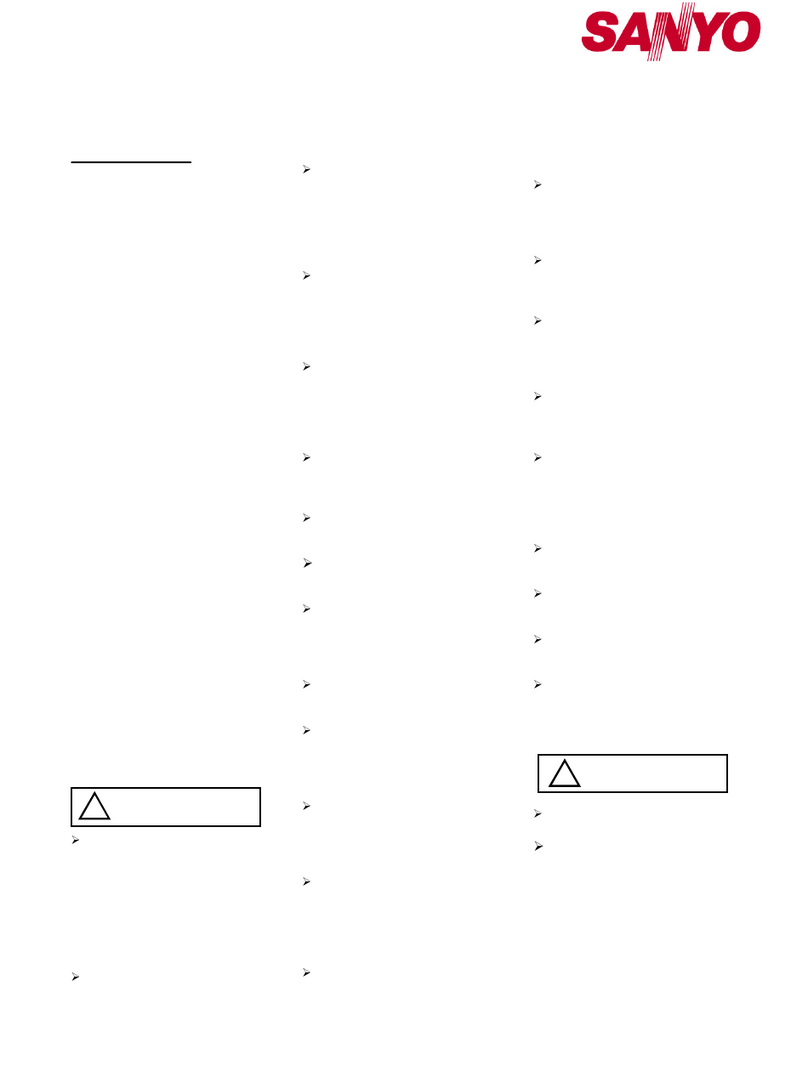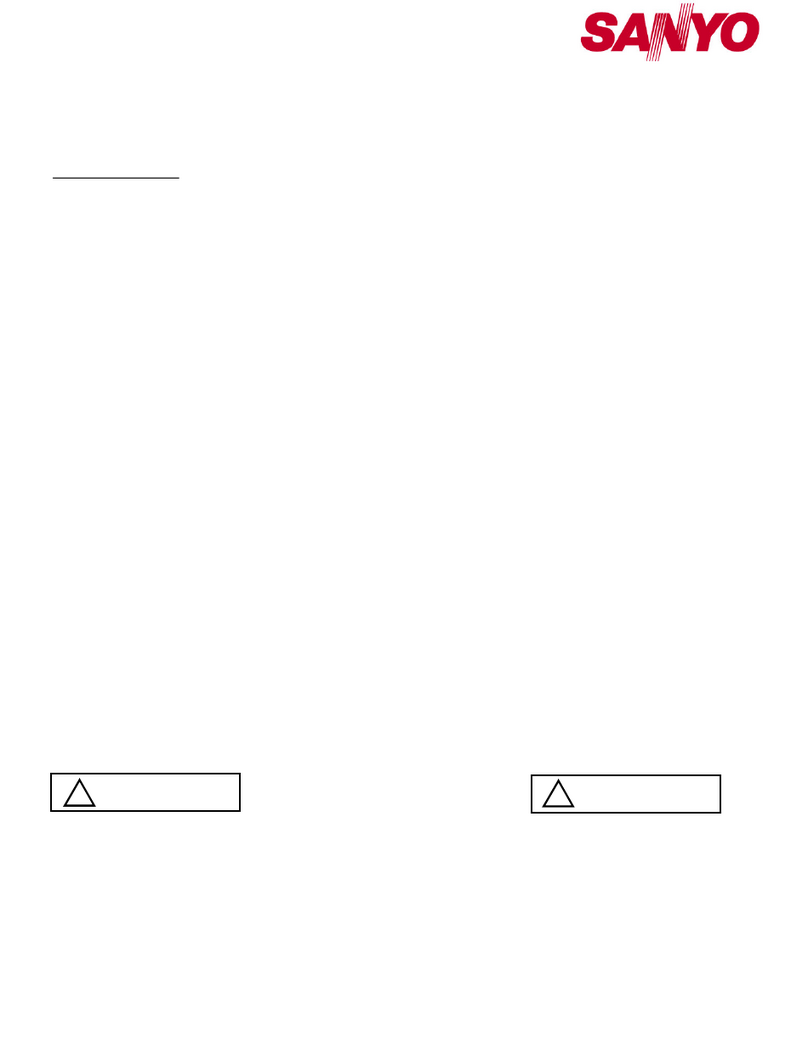
General Installation Manual
1
General Installation Manual for SANYO
HIT Photovoltaic Modules. Please read
this manual completely efore
installation or use of SANYO modules.
This manual applies to the following
products:
HIT-N220E01, HIT-N220E02,
HIT-N215E01, HIT-N215E02,
HIT-N210E01, HIT-N210E02
INTRODUCTION
Thank you for choosing SANYO HIT
photovoltaic (PV) mo ules. With proper
operation an maintenance, SANYO HIT
PV mo ules will provi e you with clean,
renewable solar electricity for many years.
This manual contains important
installation, maintenance an safety
information. The wor “mo ule” as use in
this manual refers to one or more PV
mo ules. Retain this manual for future
reference.
Disclaimer of Lia ility
SANYO oes not assume responsibility
an expressly isclaims liability for loss,
amage, or expense arising out of, or in
any way connecte with installation,
operation, use, or maintenance by using
this manual.
SANYO assumes no responsibility for any
infringement of patents or other rights of
thir parties, which may result from use of
mo ules.
No license is grante by implication or
un er any patent or patent rights. The
information in this manual is believe to
be reliable, but oes not constitute an
expresse an /or implie warranty.
SANYO reserves the right to make
changes to the pro uct, specifications, or
manual without prior notice.
General Information
The installation of solar mo ules requires
a great egree of skill an shoul only be
performe by qualifie license
professionals, inclu ing, without limitation,
license contractors an license
electricians.
WARNING
• All instructions should e read and
understood efore attempting to
install, wire, operate, and maintain
the photovoltaic module. Contact
with electrically active parts of the
module such as terminals can
result in urns, sparks, and lethal
shock whether the module is
connected or disconnected.
• The installer assumes the risk of
all injury that might occur during
installation, including, without
limitation, the risk of electric shock.
• PV modules generate DC electrical
energy when exposed to sunlight
or other light sources. Although
single modules produce only a low
voltage and current, shocks and
urns are still a potential hazard.
• To avoid the hazard of electric
shock and injury, cover the entire
front surface of the PV modules
with a dense, opaque material such
as a card oard ox, during
installation and handling of the
modules.
• The shock hazard increases as
modules are connected in parallel,
producing higher current, and as
modules are connected in series,
producing higher voltages.
• The shock hazard increases as
modules with nominal open-circuit
voltage (Voc) in excess of 50 V,
and/or modules rated for maximum
system voltage in excess of 50 V.
• To avoid the hazard of electric
shock, work only in dry conditions,
with dry modules and dry tools.
• Do not stand or step on a module
to avoid the hazard of injury and
damage to the module.
• Do not puncture or damage the
ack sheet of a module, to avoid
the hazard of electric shock and
fire.
• To avoid the hazard of electric
shock and injury, children and
unauthorized persons should not
e allowed near the installation of
PV modules.
• To avoid the hazard of electric
shock and injury, e sure to
completely ground all modules.
• To avoid the hazard of electric
shock, fire, and injury, do not
disassem le the module, or
remove any part installed y the
manufacturer.
• Unauthorized persons—except the
qualified licensed professional—
should not open the cover of the
junction ox to avoid the hazard of
electric shock.
• Do not touch terminals while a
module is exposed to light. Provide
suita le guards to prevent yourself
from direct contact with 30 VDC or
greater to avoid the hazard of
electric shock or injury.
• When carrying a module, two or
more people should carry it y its
frame and wear non-slip gloves (to
avoid injury y a slipping module,
to a foot, or cuts y the edge of a
frame, and so on).
• Do not carry a module y its wires
or junction ox, to avoid the
hazard of electric shock, injury or
damage to the module.
• Do not drop anything on the
surfaces of a module, to avoid the
hazard of electric shock, injury,
and damage.
• To avoid the hazard of electric
shock and fire, e sure that all
other system components are
compati le, and they do not
su ject the module to mechanical
or electrical hazards.
• Since sparks may occur, do not
install the module where
flamma le gases or vapors are
present.
• Never leave a module unsupported
or unsecured.
• Do not drop a module.
• Do not use or install roken
modules to avoid the hazard of fire,
electric shock, and injury.
• Do not artificially concentrate
sunlight on a module to avoid the
hazard of fire or damage.
• Do not touch the junction ox
terminals to avoid the hazard of
electric shock and injury.
• Do not change the wiring of
ypass diodes to avoid the hazard
of electric shock and injury.
• Do not disconnect terminals while
PV modules generate electricity
and connect electrical load to
avoid the hazard of electrical
shock.
CAUTIONS
• Use a module for its intended
purpose only.
• Do not treat the ack sheet or front
surface with paint or adhesives, to
avoid reducing its’ functionality,
damage, inopera le conditions,
and other unknown trou les.
GENERAL SAFETY
Follow all permission, installation and
inspection requirements.
• Before installing mo ules, contact the
appropriate authorities to etermine
permissions, installation an
inspection requirements, which
shoul be followe .
• Be sure that the construction or
structure (roof, etc.) where the
mo ules are being installe has
enough strength.
• For mo ules mounte on roofs,
special construction or structures may
be require to help provi e proper
installation support.
• Both roof construction an mo ule
installation esign have an effect on
the fire resistance of a buil ing.
Improper installation may contribute
to fire hazar s. A itional evices
such as groun fault, fuses, an
isconnects may be require .
• Do not use mo ules of ifferent
specifications in the same system.
• Follow all safety precautions of other
system components use .
































